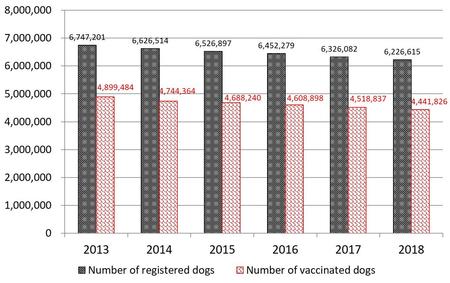Column Finance and the Social Security System 2020.07.28
【Aging, safety net and fiscal crisis in Japan】No.249: Rabies vaccinations are not being implemented as required by law
In this column series, Yukihiro Matsuyama, Research Director at CIGS introduces the latest information about aging, safety net and fiscal crisis in Japan with data of international comparison.
In June 2020, a patient diagnosed with rabies after arriving to Japan from the Philippines died. Until Japan enacted the Rabies Prevention Law in 1950, many dogs had been diagnosed with rabies there; these dogs were also infecting people, who died subsequently. Through the enactment of this law, the government made it obligatory for dogs to be registered and vaccinated, and wild dogs were detained. As a result, the rabies virus was eradicated in Japan in 1957. Since then, no dogs infected with rabies have been found in Japan.
According to the law, dog owners must get their dogs vaccinated once a year. However, as shown in Figure 1, only 4,441,826 dogs were vaccinated in 2018, although there were 6,226,615 registered dogs. Therefore, the immunization rate was 71.3%. As shown in Figure 2, there is a large disparity in the immunization by prefecture, considering that there are 47 across Japan. Yamagata had the highest immunization rate at 90.8%, while Okinawa had the lowest at 50.9%.
Figure 1 Number of registered dogs and dogs vaccinated for rabies

*Please click the table image to find the original size image.
Source: Ministry of Health, Labor and Welfare
Figure 2 Rabies vaccine immunization rate by prefecture

*Please click the table image to find the original size image.
Source: Ministry of Health, Labor and Welfare
